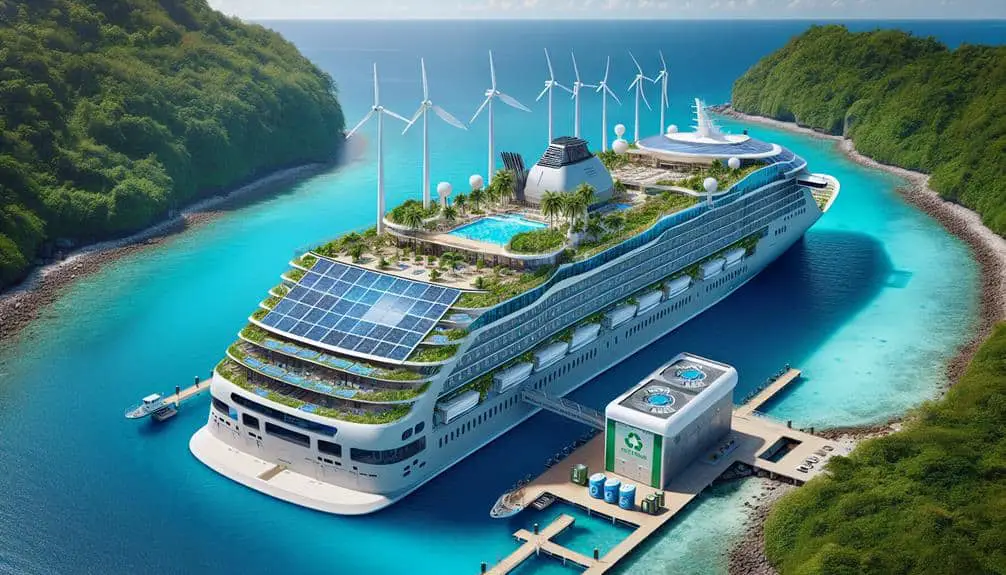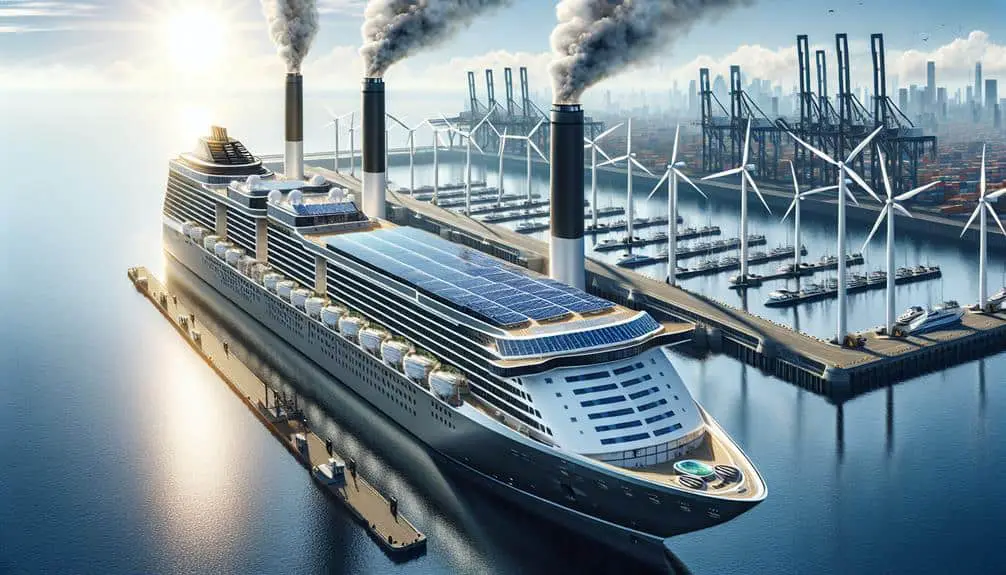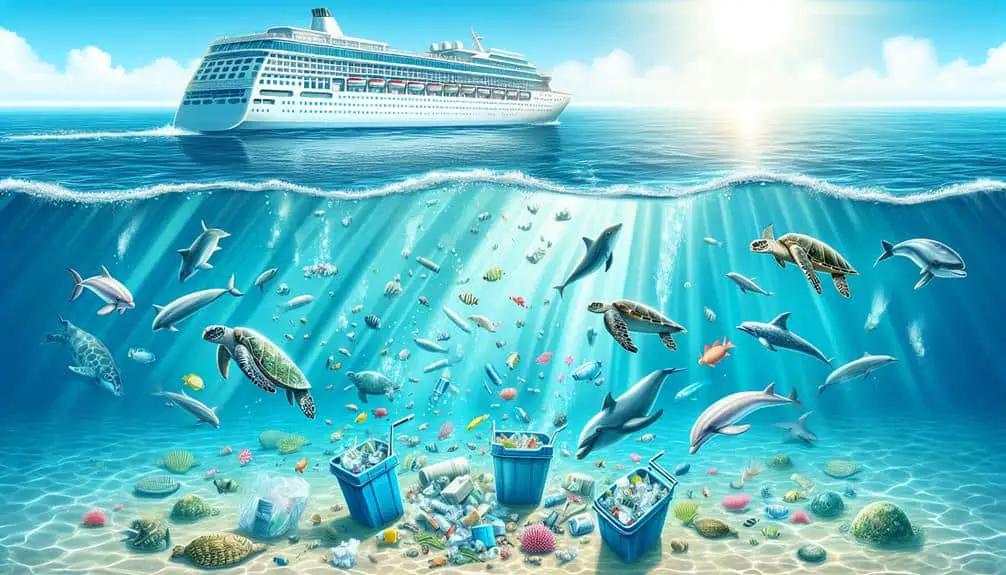Cruise ships have embraced green initiatives to protect the environment and lower their carbon footprint. They utilize solar and wind power, reducing traditional fuel dependence. Recycling programs and composting initiatives minimize environmental impact. Greywater recycling systems and advanced water-saving technologies conserve water. Eco-friendly ship designs with sustainable materials and green technologies reduce fuel consumption and emissions. Community engagement programs foster relationships with local communities and promote sustainable tourism practices. Discover how these initiatives shape responsible maritime operations and contribute to a more eco-conscious industry.
Key Points
- Solar panels and wind turbines reduce reliance on traditional fuels.
- Recycling programs and waste segregation minimize environmental impact.
- Greywater recycling and water-saving technologies conserve water onboard.
- Sustainable materials and green technologies lower emissions and waste production.
- Community engagement programs promote environmental awareness and conservation efforts.
Sustainable Energy Sources
When considering sustainable energy sources for cruise ships, utilizing a combination of solar and wind power can greatly reduce reliance on traditional fuels. Renewable fuels such as solar and wind power offer a promising solution to enhance energy efficiency while minimizing environmental impact.
Solar panels installed on the upper decks of cruise ships can harness sunlight to generate electricity, providing a clean and renewable source of power. Similarly, wind turbines strategically positioned on the ship can capture wind energy to supplement the electrical needs onboard. By integrating these renewable energy sources into the ship's energy mix, cruise lines can decrease their carbon footprint and contribute to a more sustainable maritime industry.
Moreover, optimizing energy efficiency through innovative technologies like LED lighting, smart climate control systems, and energy-efficient appliances can further enhance the overall sustainability of cruise ships. Implementing a holistic approach that combines renewable fuels with energy-efficient practices is essential in shifting towards a greener and more environmentally friendly cruise industry.
Waste Management Strategies
Implementing efficient waste management strategies is essential for cruise ships to minimize environmental impact and promote sustainability. Recycling programs and composting initiatives play an important role in diverting waste from landfills. By segregating recyclable materials onboard, cruise ships can reduce the volume of waste generated and lower their carbon footprint. Waste reduction strategies, such as minimizing single-use plastics and packaging, are key to achieving a more sustainable operation.
Circular economy approaches can also be beneficial for cruise ships. Adopting practices that focus on reducing, reusing, and recycling materials can help create a closed-loop system where waste is minimized, and resources are conserved. By implementing innovative technologies for waste treatment and disposal, cruise ships can enhance their waste management processes and contribute to a cleaner marine environment.
To guarantee the effectiveness of waste management strategies, continuous monitoring, data analysis, and improvement are essential. Collaboration with waste management experts and investing in crew training can further optimize waste handling practices. By prioritizing waste management, cruise ships can make significant strides towards a greener and more sustainable future.
Water Conservation Measures
To optimize sustainability efforts on cruise ships, adopting water conservation measures is imperative for reducing environmental impact and enhancing resource efficiency. Implementing greywater recycling systems allows for the treatment and reuse of wastewater from sinks, showers, and laundry facilities, greatly reducing the overall water consumption onboard. Efficient fixtures such as low-flow faucets, showers, and toilets further contribute to water conservation by minimizing usage without compromising functionality.
Rainwater harvesting is another effective strategy employed to supplement freshwater supplies. By collecting and storing rainwater runoff, cruise ships can utilize this alternative source for non-potable applications like deck washing and irrigation, decreasing the dependency on freshwater sources.
Integrating advanced water-saving technologies, such as water reuse systems and smart irrigation systems, enhances the overall efficiency of water management practices onboard. These innovations not only decrease water consumption but also promote a more sustainable approach to water usage throughout the cruise experience. By embracing these water conservation measures, cruise ships can significantly reduce their environmental footprint and work towards a more eco-friendly operation.
Eco-Friendly Ship Design
Efficient utilization of sustainable materials is pivotal in the development of eco-friendly ship designs to minimize environmental impact and enhance operational efficiency. Green technologies play an important role in shaping the future of cruise ships, with a focus on reducing fuel consumption, emissions, and waste production. Incorporating innovative propulsion systems, such as LNG engines or hybrid power sources, can greatly decrease the carbon footprint of vessels. Advanced hull coatings and designs aimed at reducing drag and improving hydrodynamics further contribute to enhancing fuel efficiency and overall performance.
Moreover, the use of energy-efficient lighting, HVAC systems, and smart control mechanisms on board helps optimize energy consumption, thereby lowering operational costs and environmental impact. Implementing sustainable practices in ship construction and operation not only benefits the environment but also aligns with the industry's commitment to sustainability. By embracing eco-friendly ship designs, cruise lines can set new standards for responsible maritime operations, paving the way for a greener and more sustainable future for the cruise industry.
Community Engagement Programs
Green initiatives aboard cruise ships can extend beyond eco-friendly ship design to include impactful community engagement programs that foster positive relationships with local communities and promote sustainable tourism practices. When considering community engagement programs, cruise lines can implement the following strategies:
- Environmental Education: Providing passengers with opportunities to learn about local ecosystems, wildlife conservation efforts, and sustainable practices can raise awareness and empower individuals to make environmentally conscious choices both during their cruise and in their daily lives.
- Volunteer Opportunities: Organizing volunteer activities in port destinations allows passengers to actively contribute to environmental conservation and community development projects, creating a sense of fulfillment and connection with the places they visit.
- Partnerships with Local Organizations: Collaborating with local environmental groups and community organizations can enhance the impact of community engagement programs, ensuring that initiatives are culturally sensitive, locally supported, and aligned with the specific needs of each destination.
Frequently Asked Questions
How Do Cruise Ships Handle Food Waste and Composting on Board?
When you're on a cruise ship, food waste management is essential. Many cruise lines have onboard composting programs in place. This system efficiently processes organic waste, reducing environmental impact and promoting sustainability at sea.
Are There Any Specific Regulations in Place for Cruise Ships to Reduce Air Pollution Emissions?
When it comes to regulations for cruise ships to reduce air pollution emissions, emission standards are essential. Implementing alternative fuels and enhancing energy efficiency are key strategies. By adhering to strict guidelines, ships can greatly lower their carbon footprint.
How Do Cruise Ships Manage and Treat Sewage and Wastewater to Protect Marine Ecosystems?
To uphold marine ecosystems, cruise ships manage sewage and wastewater with advanced treatment systems. Energy efficiency and water conservation technologies are utilized onboard to minimize environmental impact. These initiatives safeguard the oceans from pollution.
What Measures Are in Place to Prevent Wildlife Disturbance and Protect Marine Life During Cruise Ship Operations?
In the domain of ocean travel, safeguarding marine creatures and habitats is paramount. Cruise ships embrace wildlife conservation through eco-friendly practices, ensuring sustainable tourism. Measures like speed restrictions and waste management uphold marine life protection.
How Do Cruise Ships Promote Sustainable Sourcing of Food and Products to Reduce Their Environmental Impact?
To reduce environmental impact, cruise ships implement sustainable practices in procurement. They source food and products responsibly, considering the entire supply chain. This approach enhances sustainability efforts and minimizes negative ecological effects.




